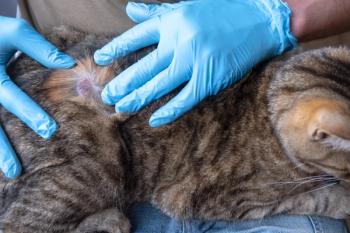
Euthanasia: a gift for suffering animals, owners say
Euthanasia has been likened to the best gift one can give an animal afflicted with chronic pain - a humane way to halt suffering.
Euthanasia has been likened to the best gift one can give an animal afflicted with chronic pain - a humane way to halt suffering.
But it's a gift that's unfathomably painful for the pet owner.
Robyn Smith, of Sag Harbor, N.Y., says she and her husband Mike werein love with Maverick, their 12-year-old Chocolate Labrador Retriever, whichdeveloped a malignant tumor in his left shoulder in 2002. By early 2003,the dog's condition had worsened considerably, forcing the Smiths to contemplatethe decision to euthanize.
"This was my first euthanasia of a dog. Dogs are people. It wasjust awful," Smith says.
To allow for peaceful, familiar surroundings for the pet's final moments,the Smiths' veterinarian performed the procedure in the back of their FordExplorer.
"The (car) was the next best thing to being home. So his last conscioustime was in his car," says Smith, beginning to break up.
To Smith, a proponent of euthanasia, the best she could offer was anend to Maverick's misery. "When we knew that Maverick had cancer andhis time was limited, (what) was comforting was knowing that this dog wasgoing to leave here with a minimum of pain, which is certainly more thanwe know about ourselves."
As for guilt, Smith says for once in her life, she felt "absolutelynone," because the timing was right. "When it's time, it's time,"she says.
Guilt was a feeling Judy Mueller, of York, Pa., hoped to avoid the secondtime around.
Expunging guilt
After Mueller's guilt-laden euthanasia experience surrounding her firstdog, an Australian Shepherd, she vowed not to do the same to her mutt, Cashie.
When her first dog's health deteriorated to a point of no return, Muellertook the dog to the veterinarian twice with plans to euthanize, but leftwith more medication. The third time, she decided she couldn't toleratethe anticipated dreadful experience and requested her husband take the animalinstead.
She called her husband later that day. "He told me he left the dogthere," she says incredulously. "I freaked out. I cried all weekendover this dog. I felt really guilty about letting my husband take this dog."
To make up for the guilt, she promised her next dog, Cashie, when hertime came, she would be there for the dog, which was afflicted with arthritisand blindness.
"The process was much quicker than I thought and so pain-free. Ifelt a lot better about my first dog and not being able to take her,"she explains.
Knowing when
Alice Luddington, of Montvale, N.J., struggled with knowing when it wastime to say goodbye to 11-year-old Cinder, a mixed breed ailed by chronicback problems.
Earlier this spring, Cinder developed a paralysis and acute pain in herrear legs following an evening walk. Luddington swiftly escorted the dogto her local veterinary clinic, where the dog stayed for two nights. Dayslater, Luddington received a call from one of the veterinarians at the clinicthat broke her heart. He explained Cinder's scenario was bleak and thatshe should strongly consider putting her down.
"I was stunned, because I thought things would get better like theyhave the times before. It was 8:30 a.m. and I had to leave work. I was sosad and crying," Luddington shares.
She had two options, the veterinarian told her. Either relieve her dogof its pain via euthanasia, or visit a specialist, who may in turn advisesurgery, which carried no guarantee.
"I felt at first he seemed brusque about it. Not a warm, fuzzy guy,but that was OK. He had his 'I'm the doctor', professional kind of hat on,"she says. As a result Luddington was still undecided, so she called herformer veterinarian in Berea, Ohio, for a second opinion.
"She was very kind. She didn't really tell me what to do. But shehelped me to decide that the euthanasia was the right choice," Luddingtonsays.
Luddington spent one final hour alone with Cinder at the clinic justholding her prior to the procedure. "She knew that I was there andthat I would take care of her," she says. After Cinder died, Luddingtonstayed behind to hold her pet one last time.
"Eventually I realized it was time for me to go. But they didn'tpressure me. I needed to be there," she says.
Saintly profession
The euthanasia experience, albeit taxing and disheartening for most petowners, is often made more tolerable thanks to veterinarians. Smith of N.Y.is convinced her veterinarians are "saints" for the professionalmanner in which they handled her recent euthanasia experience.
Following the euthanasia of Maverick, the Smiths received a letter fromTufts University that their veterinarian had donated to the veterinary schoolin the dog's name.
"I was rather bowled over about the Tufts donation," says Smith,who felt compelled to return the favor by delivering a plant to her veterinarian'soffice.
Luddington also appreciates the professionalism her veterinarians displayedtoward her. Following the euthanasia, she promptly responded with a thankyou note to the clinic.
Many pet owners say the compassion and care, humor, or even somewhatdetached professionalism, of their veterinarians helped take the edge offan otherwise traumatizing experience.
Mistakes happen
Robert Newman, an animal law attorney in Orange County, Calif., impartsa unique story of the euthanasia of his cat - a solemn experience turnedfar-fetched.
The veterinarian gave the animal a pre-anesthetic, and then left theroom for the interim before the second shot that terminates the animal'slife.
"It was all very solemn. Everyone was crying. We were in one ofthe treatment rooms and someone inadvertently hit the switch for the speakersystem and, of course, immediately filling the room with a very high volumewas Aretha Franklin singing 'R-E-S-P-E-C-T.' Everyone was in the room intears and all of a sudden, she's singing, 'What you want'
While Newman was good-natured about the experience, he says the veterinarian,a good friend of his, did recently send him an updated policy manual forhis clinic. They now verify that if any client is in for euthanasia servicesthat the power to the sound system be turned off at the front of the clinic.
Stories such as Newman's are probably few and far between. More oftenare incidences of pet owners struggling to let go once they've made thedecision to euthanize, veterinarians say.
Grief outlets
Dr. Matt Zimmerman, MD, a psychologist in Tampa, Fla., devotes a significantchunk of his practice to pet loss counseling. He says while it's commonfor pet owners to battle with their loss, they're afraid to admit it.
"There's still a stigma about seeking a psychologist about pet loss.People get a lot of messages from friends and family that they should getover it or shouldn't be experiencing the grief they're enduring," hesays.
But the message he gives clients is starkly different. "It's notabout other people understanding they lost a pet. It's about other peopleunderstanding that they lost one of the most significant relationships intheir life."
Guilt remains the number one feeling grieving pet owners express to Zimmerman,a sign, he says, of unwillingness to relinquish control.
"This is an effort to maintain the illusion of control. I could'veprevented this horrible, horrible thing if I only knew more, noticed more,thought about it more," he says.
Grief counseling offerings such as Zimmerman's also operate within universities,such as the University of California, Davis and Colorado State University,as well as private practices, like the Animal Medical Center (AMC) in Manhattan.
Dr. Susan Cohen, Ph.D., directs AMC's 20-year-old complimentary counselingprogram for pet loss. She says AMC also began the nation's first on-going,professionally-led support group open to anyone whose pets had died. A socialworker facilitates the group.
"It's incredibly helpful for people, because, one, a lot of peopledon't have anybody to talk to about their loss. They get a chance to tellthe whole story without people thinking they're nuts.
"On another level, I think we all, when we've had a terrible thinghappen, tend to repeat the story over and over in great detail, becauseon some level we're trying to figure out whether this could be avoided."
AMC is the "axle grease" trying to make the euthanasia processflow more smoothly, according to Cohen.
Newsletter
From exam room tips to practice management insights, get trusted veterinary news delivered straight to your inbox—subscribe to dvm360.




